|
Africa
2024 Journal Pages:
1
2
3
4
5
6
7
8
9
10
11
12
January
21
It was another beautiful morning, with
just a few clouds dappling the sunrise. I rode in front beside Gee
again as we set out for our last full game-driving day. The dew on
the grass shone silver in the sunlight, almost like snow - why had
we not noticed this before, I wondered? Oh, yes, that’s right -
because this was only the second morning we’d had sunshine.
After eleven straight days of rain, the sunny skies of these last
several days were very welcome. Gee said that the amount of
precipitation we had gotten on this trip was very unusual even for
the rainy season.
A comb duck was perched high in a dead tree. At first
glance he appeared black, grey and white, but in the bright
sunshine his darker feathers gleamed with shimmering hues of deep
blue and green. Also known as knob-billed ducks, these birds are
quite unique. The males have a large round disc attached to the
top of their bills; it looks ridiculous and seems like it would
block their vision, but apparently the female comb ducks find it
irresistible. I was surprised to see this duck high in a tree, but
there he was, with his webbed feet clutching the branch and the
huge disc on his bill silhouetted against the cobalt blue sky.
|
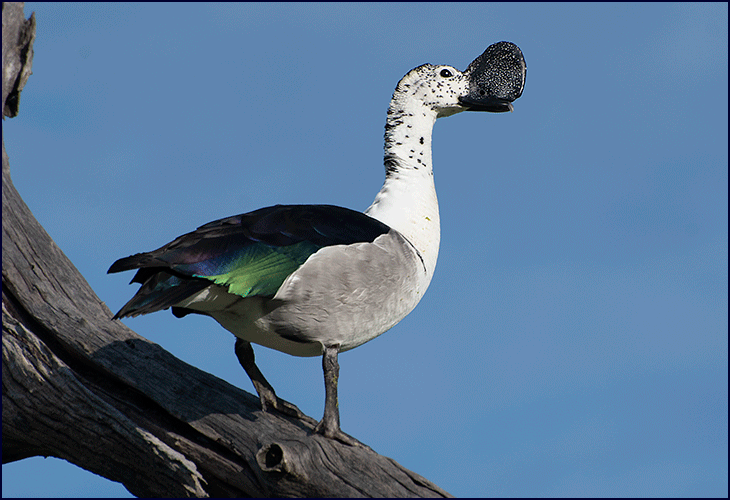
Comb duck
|
Gee pointed out a snake track across the road, he said it
was made by a cobra or a mamba. I would have loved to have seen
the snake, but not everyone in the vehicle agreed.
Gee found leopard tracks in the
dewy grass; he could tell from the disturbed water droplets that
the tracks were very recent. We heard alarm calls from both
squirrels and birds, and then saw a jackal that also was sounding
the alarm. Gee knew for sure there was a leopard in a very
specific area, but we were not able to find it. These cats are
very elusive and can hide easily under any bush; if they don’t
want to be found, they aren't. We wondered how many leopards we
might have passed within feet of on this trip and never seen.
|
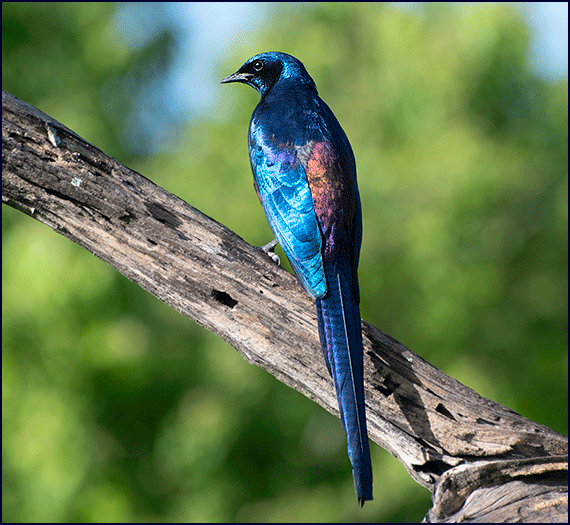
Burchell's starling
|
A
Burchell's starling sat on a branch, brilliant in the sunlight. We
had seen a lot of these spectacular birds on rainy days; now
finally there was sunshine to show off the starling’s brilliant
iridescent blue and purple plumage. Shortly thereafter we drove
very close to a marabou stork; it was quite a contrast on the bird
beauty scale.
“There is a big lizard,” Gee said, pointing to a
bent-over dead tree that looked like a velociraptor crouching by
the road.
We stopped
to speak with a self-driver; he was by himself, a very nice guy,
and unlike most we had met, he lived in Africa and knew his way
around the bush. He said he was going to fish for tilapia for his
breakfast.
Just before 8:30 we had a very
lucky sighting; a Meyer’s parrot flew into a tree. He was grey
and turquoise green with some yellow markings, and very
charismatic-looking. Gee also pointed out some red sparrows and a
dwarf bittern deep in the brush.
|
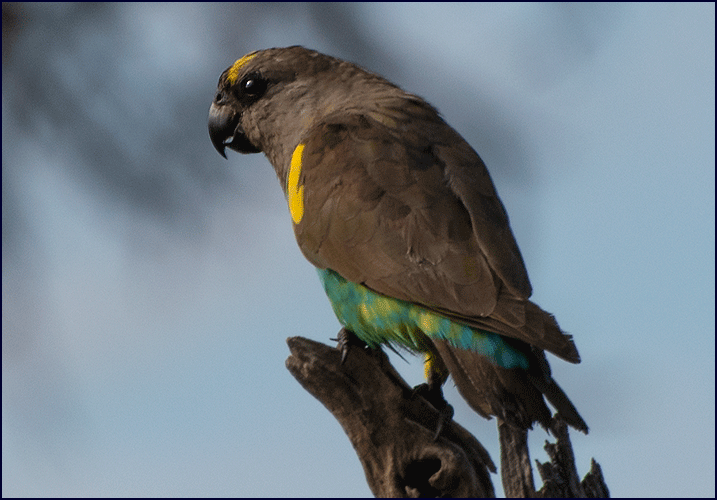
Meyer's parrot |
We saw a flash of motion in a tree near a waterhole; a martial
eagle was sitting on a high branch eating a baby goose. Very
fierce looking, the eagle was dark brown with a speckled white
chest and unsympathetic orange eyes. We watched in fascination as
he tore into his prey, partially spreading his wings and looking
around possessively.
|
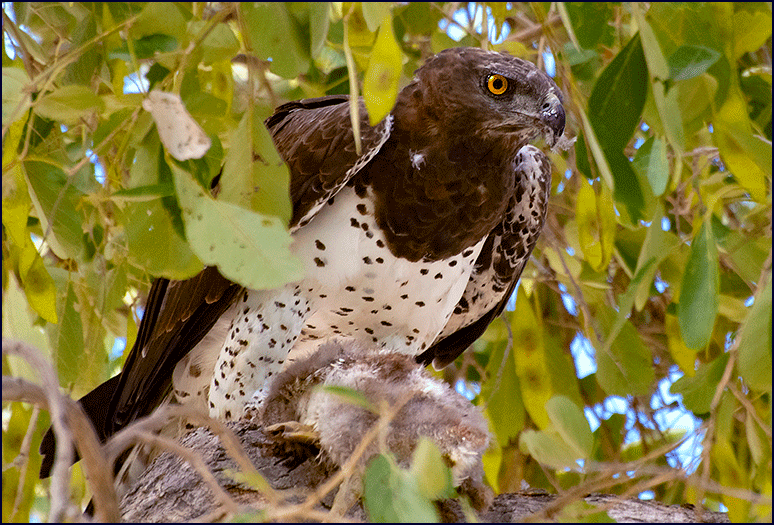
Martial eagle |
Gee pointed out some terminalia trees, which are the
elephants’ favorite. These trees fight for territory, he told
us; the terminalia secretes a chemical to keep the mopane trees
from growing near them. The elephants don’t like the apple leaf
trees all that much, and while they do eat mopane, it is not their
favorite. When they come across something they really like such as
terminalia, they tend to wipe it out. Elephants are famously poor
conservationists! Gee also pointed out a red star apple, also
called blue bush; this is known as the toothbrush tree, because
people chew the roots to clean their teeth.
We followed the river as it meandered through the wetlands.
Lilypads grew along the edge, and birds were everywhere. We
watched a group of four water thick-knees as they waded in the
shallow water; these oddly-named birds tilted their heads and
rolled their huge eyes up to watch the sky, no doubt looking for
sky-borne predators. A fish eagle flew overhead as they watched.
|
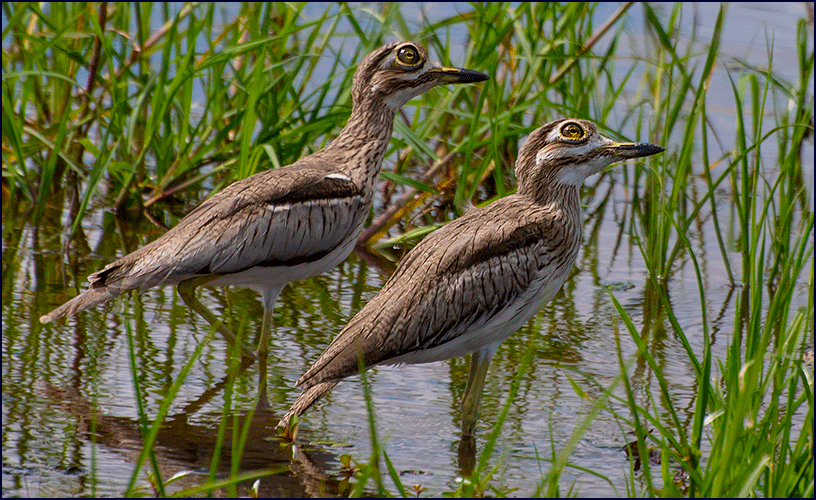
Water thick-knees |
Hippos lounged in the river, occasionally honking and
chortling humorously. As we paused to watch them, one of the big
bulls raised his head up out of the water and opened his mouth
wide to threaten us, showing off his impressive fangs –
apparently he was taking no chances that we might encroach on his
territory.
We passed another safari vehicle with six local guys and a
canoe in the back; they were going fishing. Several of them
appeared to be quite drunk.
As we returned to camp we stopped
to observe a red-billed hornbill that was posing for us on a
branch; the sunshine had made this an excellent morning for bird
photography.
We took a group photo by the land cruiser before going out
for the afternoon drive; I put my phone camera on timer mode and
wedged it in a camp chair so we could all get in the shot. Then we
were on the road about four o'clock.
We
looped through the woods and had a quick look at an enormous hippo
out of the water, watching his round backside as it disappeared
into the trees. We passed some shy kudus, more baby wildebeests,
and the ever-present impalas.
We sat for a long time watching a troop of baboons. The
dominant male sat high on a tree branch in a quiet dignified
manner while some of the youngsters played boisterously. They ran
up and down the tree trunk, swinging from the branches like
Tarzan, hanging upside-down from a vine by one hand, letting go
and tumbling to the ground, and then running up the trunk to do
the whole thing over again. They were hilarious to watch.
We
spent some quality time with four giraffes. We watched them up
close while they browsed near the road, their long tongues and
mobile lips delicately separating tasty leaves from the thorns. A
fish eagle surveyed us from a tree, and we saw several more
Meyer’s parrots.
The
guys in the safari truck with the canoe drove back past us.
They’d had a successful day of fishing; one of them proudly held
up a string of about twenty-five tilapia. They would be eating
well tonight!
A huge warthog was grazing
right beside the road. To our delight he was not at all shy,
unlike most of his kind, and he took no notice of us being very
close. He was enormous, and looked really old. He grazed on his
knees, as warthogs’ necks are too short to reach the ground
while standing. He had a long stringy mane, sparse wiry body hair,
lethal-looking curved tusks, and truly impressive knob-like
protuberances on the side of his face. Gee told us that warthog
meat is delicious, much better than pork.
We went back down to the
river and drove along its shore. We came to a particularly
beautiful spot where the river widened out and the water was very
still; the trees and clouds were reflected on the glassy surface.
A fish eagle called out, a high-pitched mournful cry. Suddenly we
realized this had been our camping spot on a previous trip; it was
very remote, and had probably been our favorite campsite of all
time. A pair of fish eagles had nested in a tree, and we had
called it the Fish Eagle Camp. One morning we had watched thirty
elephants as they crossed the water right by our tents.
Gee heard a call from a giant eagle owl, and while we were
looking for it he found more leopard tracks. We went searching for
both but found neither; we didn’t care - we were enjoying the
hunt.
We drove back to Lechwe Plain to watch the sunset. A few
hippos waddled about, and white-faced ducks flew in for a landing.
A herd of lechwe stood looking at us, then loped across the
floodplain through the shimmering silvery grass, backlit against
the sunset. The sky, accented with bands of clouds, glowed in
shades of orange, red and magenta. Several egrets gleamed white
against the darkening plain. The last rays of the sun reflected on
the winding river. It was peaceful and beautiful. We were sad that
this was our last night out on safari.
Our plan had been to go back to the hyena den again, but
Gee received a radio call from another guide who told him that the
hyenas were not out this evening. We lingered on the plain for a
while, watching the three-quarter moon come out as the light
faded. Driving back to the edge of the plain just as the sun
slipped below the horizon, we passed a large tree beside the
river, silhouetted against the darkening sky. A pair of giant
eagle owls sat on a branch; we could just barely see them in the
dim light.
It was very dark as we drove the road back to camp.
Suddenly we saw a vague shape crossing the road ahead of us, and
Gee saw its eyes in the dark - it was a lion. We went off road
briefly looking for him, shining a high-power flashlight, and
found him under the bushes by his glittering eyes. He was very
shy. Gee said a shy lion is an aggressive lion, so we left him be.
But wow, lion number forty!
We enjoyed our usual comradery around the fire and the
dinner table. We were very sad it was our last night; I think we
all would have loved to stay longer. About the only thing we
missed were our soft beds at home.
I took a shot at composing a couple of limericks that would
sum up our feelings; I think the result was one of my better
efforts, and it came from the heart. I recited them at the dinner
table:
Gee’s
bushcraft is second to none
There’s nothing he’s not seen or done
For animals and birds
He finds the right words
To make learning about Africa fun.
Our
Journey with Gee’s near the end
The days, they went by like the wind
We are sorry to be going
But we go home knowing
That in Botswana we have a friend.
We heard lions, hyenas, hippos and frogs all calling in the
night. A hippo was grazing very close to Natalie’s tent. When I
went out to the bathroom at about three in the morning, bright
stars filled the dark velvet sky; not as brilliant as the stars of
an African winter, but still amazing.
January 22
It was our last moving day; we
headed out just after six on the road back to Maun. The silver dew
lay on the grass, transforming the bush into a crystal paradise.
Gee spotted honey badger tracks in the road; he said they were
made after the dew was on the grass, so in the last hour. A large
hippo hurried through the trees, on his way back to the water
after a night of grazing on land.
A tawny eagle perched high on a branch, silhouetted against
the brilliant blue sky. We stopped to watch an elephant that was
eating wild cucumbers by the road. We marveled at how the tip of
his trunk was like prehensile fingers, with which he would grasp
the vines delicately. The area was carpeted with yellow flowers
like buttercups; Gee told us they are called Devil’s Thorn, and
when they dry out they have sharp thorns that are hard on the
animals’ feet.
All good things come to an end, and presently we left the
bush and came back to the buffalo fence, and then on to the main
road to Maun. When we’d left camp that morning Gee had told us
there would be no lunch on the road because they were out of
supplies; so instead he took us to his island for lunch.
Gee owns a camping site on an island not far from Maun; at
this time of year we were able to drive to it, but when the
Okavango Delta floods the only access is by boat. When we arrived
we met up with Gee’s fiancé and one of his daughters, Thembi,
as well as his brother Sam, who some of us knew from a previous
trip. It was great to
see them all.
Gee had arranged a surprise for us.
A group of dancers from the Bambukusu tribe were there on
the island to perform their traditional dance and music for us.
There were 17 dancers, and they were fabulous. They did
four numbers for us, energetic dances accompanied by music from
drums, percussion instruments and whistles, as well as chanting
and singing. Their performance was authentic and delightful.
The dancers’ costumes were impressive. They wore thick
bushy skirts that reminded one of ostrich plumes, but made from
bamboo beads. Several of the featured dancers had zebra manes on
their shoulders, and they were able to move their shoulders in a
way that made them swing back and forth wildly.
It was an amazing experience, and a great end to our trip.
January
23
Gee and his brother Sam picked us
up in the morning and drove us to the Maun airport. I was sad to
say goodbye; though part of me was ready to get back to my farm
and business, another part of me halfway wanted to run away from
home and just live in Africa forever. But the good news was we
were already planning our next trip with Gee and Makomkom Safaris.
I can’t wait to go back!
~ The End ~
Africa
2024 Pages:
1
2
3
4
5
6
7
8
9
10
11
12
Back
to the AFRICA 2024 INDEX Page
|